 Smartphones. Useful, expensive, and indispensible. An entire secondary market has arisen to provide smartphone accessories, the most prolific being protection devices. Cases, skins, covers – there seem to be almost as many of them as there are users of smartphones, and they serve purposes ranging from fashion to actual hard-core protection. The Trident Kraken AMS Case falls into the latter category. Its base is a multi-layer protective case, and it also features several modular add-on attachments that allow the user to customize the case to their particular activities. I had the opportunity to evaluate a Kraken AMS for my iPhone 4S. Let’s release the Kraken!
Smartphones. Useful, expensive, and indispensible. An entire secondary market has arisen to provide smartphone accessories, the most prolific being protection devices. Cases, skins, covers – there seem to be almost as many of them as there are users of smartphones, and they serve purposes ranging from fashion to actual hard-core protection. The Trident Kraken AMS Case falls into the latter category. Its base is a multi-layer protective case, and it also features several modular add-on attachments that allow the user to customize the case to their particular activities. I had the opportunity to evaluate a Kraken AMS for my iPhone 4S. Let’s release the Kraken!
Click Any Image to Enlarge
Ordering Info
I don’t typically explain ordering information as the beginning of a review, but Trident has a bit of a confusing site setup, so I thought it best to mention it. The main Trident site, Tridentcase.com, shows product information, but redirects to Tridenteer.com (catchy name, eh?), a subsidiary site, for additional product detail and to actually order products.
Packaging
The Kraken AMS, which stands for Adaptive Modular System, arrived in a black cardboard box with hinged clamshell lid. On the front in silver print was the Kraken AMS logo and several illustrations of objects that give hints as to the types of activities for which the system has been designed to be used.
Opening the box revealed the contents, with each item in the system presented in its own cavity cut into a thick foam block. Here I need to note that this was some type of launch kit specifically sent out to review sites. Perhaps Trident will make this full kit available in the future, but it doesn’t appear to be available packaged together like this yet.
The core of the system, the Kraken case, had its own separate package, designed for individual sale. The Kraken package’s transparent plastic blister gave excellent views of the product that may help potential buyers with a purchasing decision.
The back of the Kraken was highly visible as well, including its Belt Clip/Holster. More on the Kraken itself below.
Inside the Box
Removing all of the items from the packaging, the contents are listed and shown below:
The Kraken Case
Breaking down the Kraken Case contents:
- Perseus silicone skin
- Exoskeleton plastic front shell
- Exoskeleton plastic rear shell
- Rear screen protector
- Rear screen protector installation card
- Headphone jack adapter
- Microfiber cloth
- Instruction booklet
The Kraken Case concept is similar to the Otterbox Defender, the Griffin Survivor, and other rugged, uber-tough style cases in that it consists of multi-layer potection for a smartphone. However, unlike many of the more popular tough cases, the Kraken Case’s outermost layer is a hard plastic shell, while its innermost layer is a soft silicone skin. This will be described in detail below. One thing to note is that, like many of the “tough” cases, while the Kraken Case is fairly water resistant, it is NOT waterproof. If you want that, you should probably consider something like the LifeProof Case. Below is a pic of the fully-assembled Kraken Case from the front. It is available for many different smartphones and in multiple color schemes (here “Trident Green”) and at various prices (most are about $50). Here I’m using my iPhone 4S to illustrate the Kraken AMS’s features.
Kraken Case: Perseus Soft Silicone Skin
The innermost layer of the Kraken Case is the Perseus silicone skin. Note that Trident also sells the Perseus separately and it is available in various colors for $14.95. Because the entire system is modular, you could buy a Perseus in a different color to suit your liking and use it with the rest of the components of the Kraken Case.
 The shock-absorbing silicone skin has a pleasant, soft feel, providing nice grippability (Is that a word? It is now.) and is easy to install. Its front opening is large enough to provide access to the touchscreen and the home button. It covers the area above the screen and provides openings for the front-facing camera, the phone speaker and the proximity sensor.
The shock-absorbing silicone skin has a pleasant, soft feel, providing nice grippability (Is that a word? It is now.) and is easy to install. Its front opening is large enough to provide access to the touchscreen and the home button. It covers the area above the screen and provides openings for the front-facing camera, the phone speaker and the proximity sensor.
 The back of the skin provides a cutout for the rear-facing camera and flash, plus a cutout to display the Apple logo, or as I like to call it, a vanity window. This vanity window is open with no clear film or plastic; however, if you install the rear screen protector that is supplied with the Kraken Case, it will provide some protection to portion of the phone that is exposed here.
The back of the skin provides a cutout for the rear-facing camera and flash, plus a cutout to display the Apple logo, or as I like to call it, a vanity window. This vanity window is open with no clear film or plastic; however, if you install the rear screen protector that is supplied with the Kraken Case, it will provide some protection to portion of the phone that is exposed here.
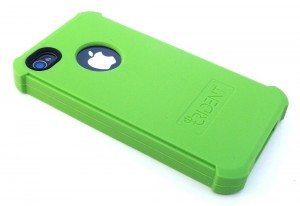 The rear camera cutout includes a hard plastic insert with an inwardly-beveled opening, presumably to help the cutout hold its shape and to prevent the dreaded flash distortion that has been reported with other cases.
The rear camera cutout includes a hard plastic insert with an inwardly-beveled opening, presumably to help the cutout hold its shape and to prevent the dreaded flash distortion that has been reported with other cases.
As far as silicone cases go, it’s not the thinnest one out there, but it’s not that bad. Also, the texture and material is such that its lint magnetism isn’t bad either.
The left side of the skin has two cutouts, one for the mute switch, the other for the volume up/down buttons.
 The top of the skin includes a cutout for the headphone jack and top microphone on one end and a small nub that covers the sleep button on the other end.
The top of the skin includes a cutout for the headphone jack and top microphone on one end and a small nub that covers the sleep button on the other end.
 The bottom of the skin includes two small slit-shaped cutouts for the speaker and microphone ports, as well as a large cutout for the 30-pin dock connector.
The bottom of the skin includes two small slit-shaped cutouts for the speaker and microphone ports, as well as a large cutout for the 30-pin dock connector.
 Kraken Case: Exoskeleton Hard Plastic Shell
Kraken Case: Exoskeleton Hard Plastic Shell
The silicone skin is decent everyday protection. It’ll absorb bumps and dings pretty well. But maybe you’d like to add another layer that provides additional protection. The Kraken Case gives the option of adding, over the Perseus silicone skin layer, an additional Exoskeleton hard polycarbonate plastic shell layer with built-in screen protector. Like the Perseus skin, the Exoskeleton shell it is available separately for $34.99 in various colors for customization. 
Let’s start with the front shell, which is hard plastic with matte finish that slides over the silicone skin. It is a bit difficult to install and requires the volume button side to be inserted first, and a combination of careful alignment and gentle tugs here and there to get the silicone skin to tuck into the nooks and crannies, and especially to keep the sleep/wake button nub from being sheared off. Yikes.
 With the front shell installed, the back is still protected by the silicone skin. One could use the Kraken AMS in this way, with only the front shell attached, if desired.
With the front shell installed, the back is still protected by the silicone skin. One could use the Kraken AMS in this way, with only the front shell attached, if desired.
The front shell includes cutouts which allow the silicone skin to protrude from the corners as bump protection.
 The skin and shell have been designed such that the sides of the shell fit down into recesses between the protruding skin corner bumpers, giving it an integrated look around the periphery.
The skin and shell have been designed such that the sides of the shell fit down into recesses between the protruding skin corner bumpers, giving it an integrated look around the periphery.
 The left side of the front shell includes a generous cutout around the volume mute switch, with the silicone skin surrounding it. The volume up/down buttons are covered by separate plastic push buttons, which have an excellent tactile, clicky feel.
The left side of the front shell includes a generous cutout around the volume mute switch, with the silicone skin surrounding it. The volume up/down buttons are covered by separate plastic push buttons, which have an excellent tactile, clicky feel.
 Both the left and right sides of the front shell, as well as the face, include cosmetic, faux “bolts” which are not just cosmetic, but also serve as attachment points for the rear shell (more on this below).
Both the left and right sides of the front shell, as well as the face, include cosmetic, faux “bolts” which are not just cosmetic, but also serve as attachment points for the rear shell (more on this below).
The top of the face of the front shell has a cutout for the front camera, phone speaker and proximity sensor, all of which are further protected by the silicone skin beneath.
The top of the front shell includes a cutout through which the silicone skin’s sleep/wake button nub protrudes. On the opposite end is a cover for the headphone jack and top microphone. The cover is a silicone flap that is built into the shell that has a tiny hole for the top microphone and a small ridge to aid in opening it.
The flap fits fairly tightly and can be opened and closed easily. However, its attachment point is quite narrow, and I would consider it to have a high tear-off risk, especially considering the microphone hole further reduces its cross-section, and therefore its shear strength.
 The bottom of the front shell includes two narrow slits for the bottom microphone and speaker. The skin and shell have been designed to direct sound through channels in the case and toward the face of the phone, and it actually works quite well.
The bottom of the front shell includes two narrow slits for the bottom microphone and speaker. The skin and shell have been designed to direct sound through channels in the case and toward the face of the phone, and it actually works quite well.
Also present in the bottom of the front shell is a flap to cover the 30-pin dock connector. The flap includes a similar ridge to the headphone jack flap to aid in opening.
 The front shell consists of a hard plastic frame that protects the face and sides of the phone, while allowing access to the phone’s features via various portals and pass-throughs. As mentioned above, it also includes a built-in screen protector.
The front shell consists of a hard plastic frame that protects the face and sides of the phone, while allowing access to the phone’s features via various portals and pass-throughs. As mentioned above, it also includes a built-in screen protector.
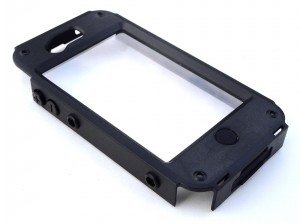 The iPhone’s home button is covered by a silicon button cover, which retains a tactile feel when depressed.
The iPhone’s home button is covered by a silicon button cover, which retains a tactile feel when depressed.
 Underside of the the front shell. Here you can see the underside of the home button silicone cover as well as the underside of the volume pusher buttons.
Underside of the the front shell. Here you can see the underside of the home button silicone cover as well as the underside of the volume pusher buttons.
 Another view of the underside of the front shell.
Another view of the underside of the front shell.
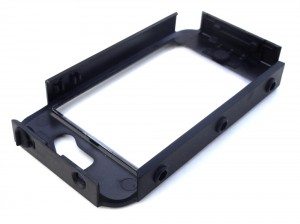 A closeup of the silicone home button cover and dock connector cover.
A closeup of the silicone home button cover and dock connector cover.
A shot of the underside of the top of the front shell. Visible are the cutout for the sleep/wake button as well as the headphone jack/microphone cover and the phone speaker cutout.
 Closeup of the volume pusher buttons from the inside.
Closeup of the volume pusher buttons from the inside.
The Exoskeleton also includes a hard plastic rear shell that, once installed, makes the Kraken Case a quite stout protective barrier.
 The back shell fits over the sides of the front shell.
The back shell fits over the sides of the front shell. The back shell includes two cutouts, one for the rear camera and flash and one for the Apple logo. It also includes several ribs to increase grip.
The back shell includes two cutouts, one for the rear camera and flash and one for the Apple logo. It also includes several ribs to increase grip.
 Also included is the kickstand, which is actually the heart of the AMS’s modularity. More on this below.
Also included is the kickstand, which is actually the heart of the AMS’s modularity. More on this below.
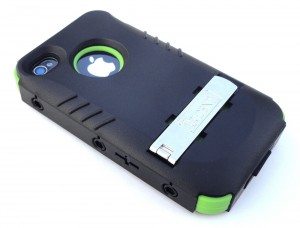 The back shell is attached at the faux hex-bolts on the sides of the front shell, snapping over them and locking securely.
The back shell is attached at the faux hex-bolts on the sides of the front shell, snapping over them and locking securely.
The back shell includes cutouts through which the volume up/down buttons from the front shell protrude, as well as a silicone flap over the volume mute switch.
The bottom of the phone remains protected by the front shell alone…
 …and likewise the top of the phone remains protected by the top of the front shell. Note also that the silicone Perseus skin still protrudes through the Exoskeleton shell at the corners to provide bump protection in those areas.
…and likewise the top of the phone remains protected by the top of the front shell. Note also that the silicone Perseus skin still protrudes through the Exoskeleton shell at the corners to provide bump protection in those areas.
The top of the back shell includes two portals, both beveled. One is oval-shaped for the rear camera and flash, the other is circular to display the Apple logo. As mentioned above, I call this a vanity window. A fair number of people who buy iPhones seem to like to show off the fact that they have an iPhone – beside being a great device, it is also somewhat of a fashion accessory. However, advertising that you have an iPhone may open you up to attempts at theft of your device. Just something to keep in mind with cases that include a vanity window.
The kickstand is made of aluminum with a satin finish. It is in two pieces and hinged on one end. The other end has a hook which locks it down flat and out of the way when not needed.
 Another view of the deployed kickstand.
Another view of the deployed kickstand.
 The kickstand can be used for just that: to prop your phone at an angle (landscape mode only) for watching videos and so forth. More on the kickstand below.
The kickstand can be used for just that: to prop your phone at an angle (landscape mode only) for watching videos and so forth. More on the kickstand below.
 A few views of the back shell.
A few views of the back shell.
 From these views of the the underside of the front shell, the cutouts and portals are visible, as well as the internal ribs which give rigidity and support to the shell.
From these views of the the underside of the front shell, the cutouts and portals are visible, as well as the internal ribs which give rigidity and support to the shell.
The fully-assembled Kraken Case, with Perseus silicone skin and the Exoskeleton’s front and rear shells, is quite the beast. No wonder Trident calls it the Kraken. It adds both size and mass to what begins as a very svelte iPhone 4S. However, the Kraken Case is intended for use in harsh environments, for hard use, and for dangerously clumsy people. It’s not a bumper or a slider, it’s a tank. It provide a significant level of protection at the expense of size and weight, and users who need need this usually accept the tradeoff.
Belt Clip/Holster
The main accessory to the Kraken Case is the Belt Clip/Holster which functions similarly to other “tough case” belt clips.
The belt clip consists of a spring-loaded clamp that attaches to the belt, a base plate with a clicking swivel mechanism, and a bracket that attaches to the Kraken Case.
The clips locks at two points on either side of the Kraken Case’s back shell. Here you can see that the mounting position is off-center relative to the Kraken Case. More on this later.
The attachment points are cross-shaped features which mate together in male-female fashion. It was difficult for me to align the features and lock them together without looking down at it, even after using the case for several weeks. This was quite frustrating, especially a few times when I thought I’d had the case locked into the holster, but didn’t, and the phone fell and hit the floor. Good thing it was in the Kraken Case, I suppose.
The Belt Clip’s clicking swivel feature allows it to be oriented vertically or horizontally. Using the Belt Clip, the Kraken Case sits fairly far off your belt in vertical orientation, but not much farther than other, similar cases.
The clicking swivel feature of the belt clip allows the Kraken to be oriented several discreet positions from vertical all the way to horizontal.
In the horizontal orientation, due to a combination of the design of the belt clip itself and the fact that the clip’s attachment bracket is offset from the centerline of the Kraken, the phone rides in a somewhat odd and more awkward position than it does vertically. See below.
Modularity: Removing the Kickstand
The heart of the AMS actual modularity lies with the kickstand, or rather the feature into which the kickstand is attached. The kickstand sits in a slot in the back shell and can be removed by sliding it forward or backward slightly, releasing two tabs that secure the kickstand to the case.
With the kickstand removed, all of the Kraken AMS’s other modular accessories can be attached, but only one at a time, as described below. I actually found it fairly difficult to remove the kickstand for the first time, as it was very tight, but after that it did seem to get slightly easier each time. This could be a problem for people who play to swap out their Kraken’s accessories frequently.
Seatbelt Clip
Let’s start our tour of the Kraken A.M.S.’s modular attachments with the Seatbelt Clip. The Seatbelt Clip is available separately for $14.95, in any color as long as its black.
The Seatbelt Clip consists of an alligator-style hinged clamp with small internal ribs to grip the seatbelt. The clamp is secured with a small locking clip on the open end.
On the back of the Seatbelt Clip is the slide-lock feature that allows it to mate with and lock into the rear shell of the Kraken Case.
The Seatbelt Clip, like the Belt Clip/Holster, rotates to allow it to be positioned in various orientations.
I actually used the Seatbelt Clip to attach the Kraken Case to the strap of my messenger bag and used it to listen to music while having the phone accessible.
Bike Rail Clip
Next up, the Bike Rail Clip, available separately for $14.95. It consists of two half cylinders that fit over a bike’s handlebar tubing and are secured by tightening two metal wingnuts. Again, available in a wide variety of black-only colors.
The Bike Rail Clip’s attachment to the Kraken Case involves squeezing two spring-loaded pushers together and then sliding it onto the attachment feature on the Kraken’s Case’s rear shell.
The Bike Rail Clip attaches quite securely to the rear shell.
Below are visible the two rubber pads inside the Bike Rail Clip that help to grip a bike’s handlebars.
I attached the Bike Rail Clip to a set of bike handlebars. It only took a few seconds to install and could be easily adjusted to provide a better view of the phone’s screen by loosening and re-tightening the wing nuts.
Wire/Headset Organizer
The Wire/Headset Organizer is a device intended for management of earbud cables. It consists of a hard plastic spool core, a silicone flap and a baseplate that attaches to the Kraken Case. Like the other accessories, it is available separately for $14.95, and currently only in Trident Green color scheme.
Below is a shot of the attachment feature on the baseplate.
Earbud cables are wound around the interior plastic spool, with the cable being held in check by the silicone flap. The flap has small slots on either side that allow the cable ends to stick out. The Wire/Headset Organizer does its job well enough, but I found it to be a bit cumbersome in size.
Camera Mount
The Tripod Mount is an attachment for you iPhonographers out there. It allows the Kraken Case to be attached to a standard camera tripod via a threaded connection. It is available separately for $14.95 in black.
The mounting bracket that attaches to the Kraken Case:
The Camera Mount does not swivel and can be attached in two orientations relative to the Kraken case.
A few shots of the Camera Mount on a tripod.
Windshield Mount
The Windshield Mount attachment allows the Kraken to be mounted to a car’s windshield. It consists of two parts: a lever-assisted suction cup which attaches to the windshield glass, and a bracket which attaches to the Kraken case. The Windshield Mount is available separately for $14.95 in, you guessed it, black.
Pinching two spring-loaded tabs allows the Windshield Mount to be slide-locked into the slot on the Kraken Case.
The Windshield Mount is articulated in two places. At the suction base is a hinge joint which allows the arm to be positioned in several discrete angles. At the case attachment bracket is a ball-and-socket joint which allows finer adjustment of the viewing angle of the case to your liking.
The suction cup’s lever mechanism was very difficult to latch, but once locked down, it was very solid. It felt like I could do chin-ups on it, if I were so inclined to do such a thing from my windshield.
The Windshield Mount allows you to choose where you’d like to mount your phone, shown below in several locations for comparison.
Conclusion
The Trident Kraken AMS offers not only a “tough”-style case with multi-layered protection, but the modular attachments add to its usefulness and customizability. However, purchasing the Kraken Case and all of the Attachments would be quite expensive (a total of $124.70 if purchasing everything in this review), but you may not need all of the attachments based on your needs.
Update 03/26/2015
This was a really great case setup. All the bells and whistles. But eventually got tired of the bulky, heavy-duty type case and wanted something a bit slimmer, so I stopped using the Kraken.
Source: The sample for this review was provided by Trident Case. Please visit their site for more info.
for MagSafe Wallet, Stronger Magnetic Wallet for iPhone 17/16/15/14/13/12 Series, 7 Cards Holder, Magnetic Phone Wallets, Vegan Leather Minimalist Slim RFID for iPhone Wallets, 1 Slot, Black & Black
$19.98 (as of December 8, 2025 11:45 GMT -05:00 - More infoProduct prices and availability are accurate as of the date/time indicated and are subject to change. Any price and availability information displayed on [relevant Amazon Site(s), as applicable] at the time of purchase will apply to the purchase of this product.)ESR for MagSafe Wallet with Stand, RFID Blocking with MagSafe Ring, 5 Card Holder for Phone Case, Slim Leather Magnetic Wallet for iPhone 17/16/15/14/13/12 Series(Not for Mini), Selected Samsung,Black
43% OffProduct Information
| Price: | Kraken Case $49.95, Attachments $14.95 each (as reviewed, $124.70 total) |
| Manufacturer: | Trident Case |
| Retailer: | Tridenteer |
| Pros: |
|
| Cons: |
|































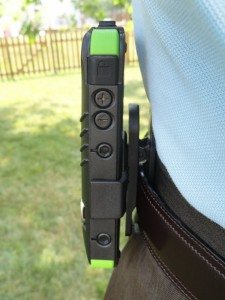





























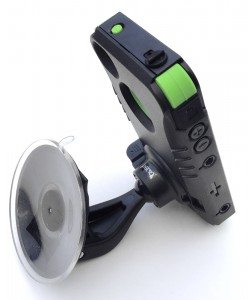






Gadgeteer Comment Policy - Please read before commenting
You forgot to mention that the silicone case blocks wifi. Kills your battery and even reduces cell signal.
@Mike – I did not notice what you are describing.